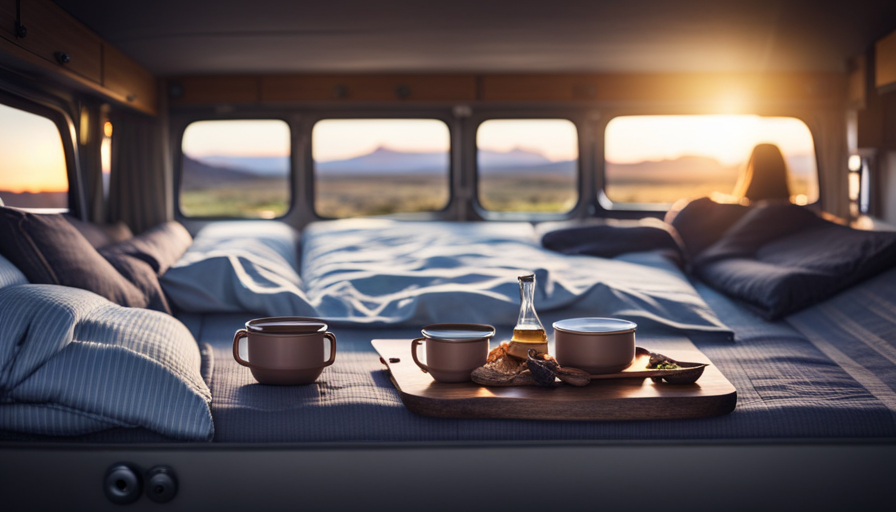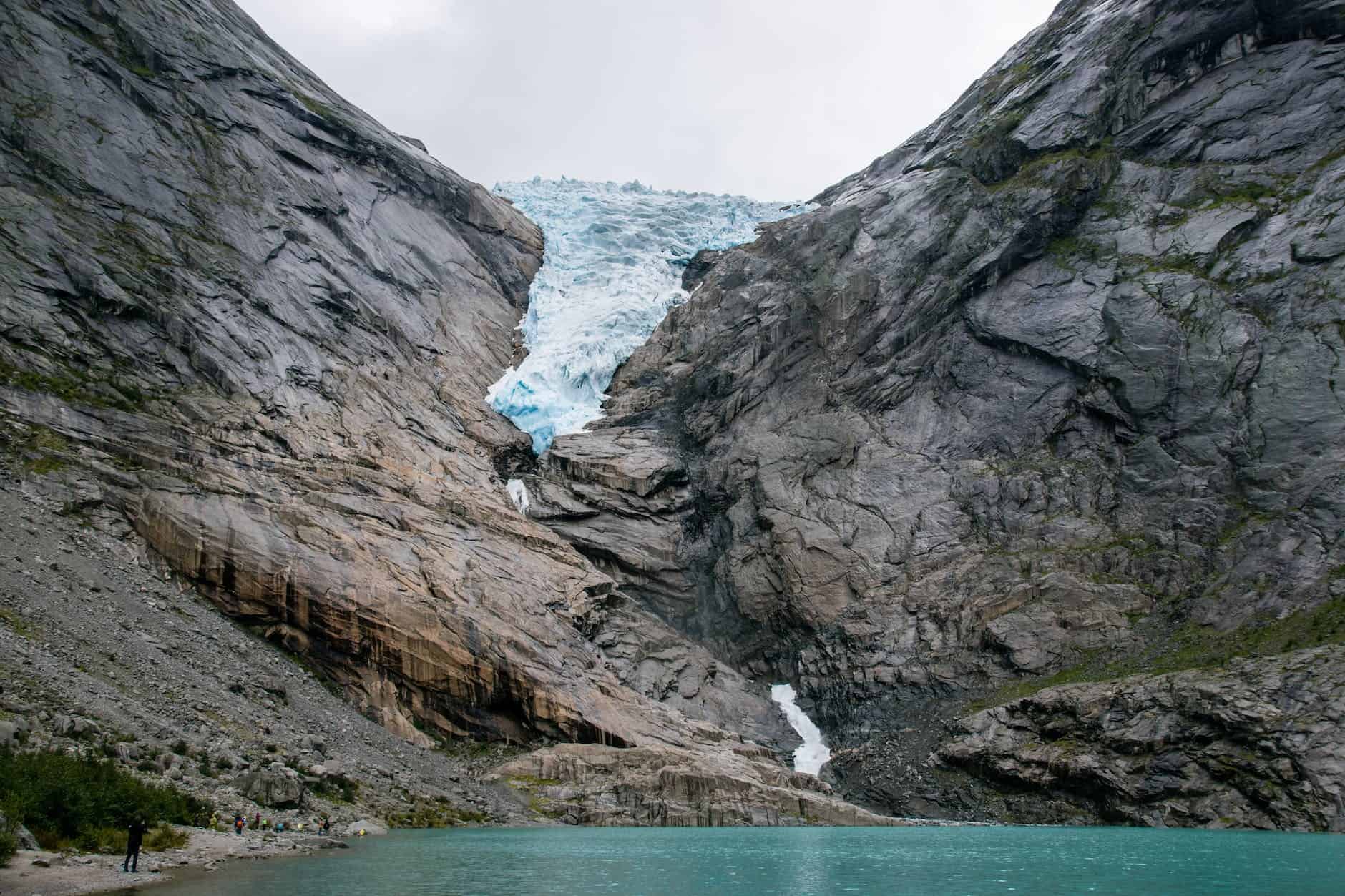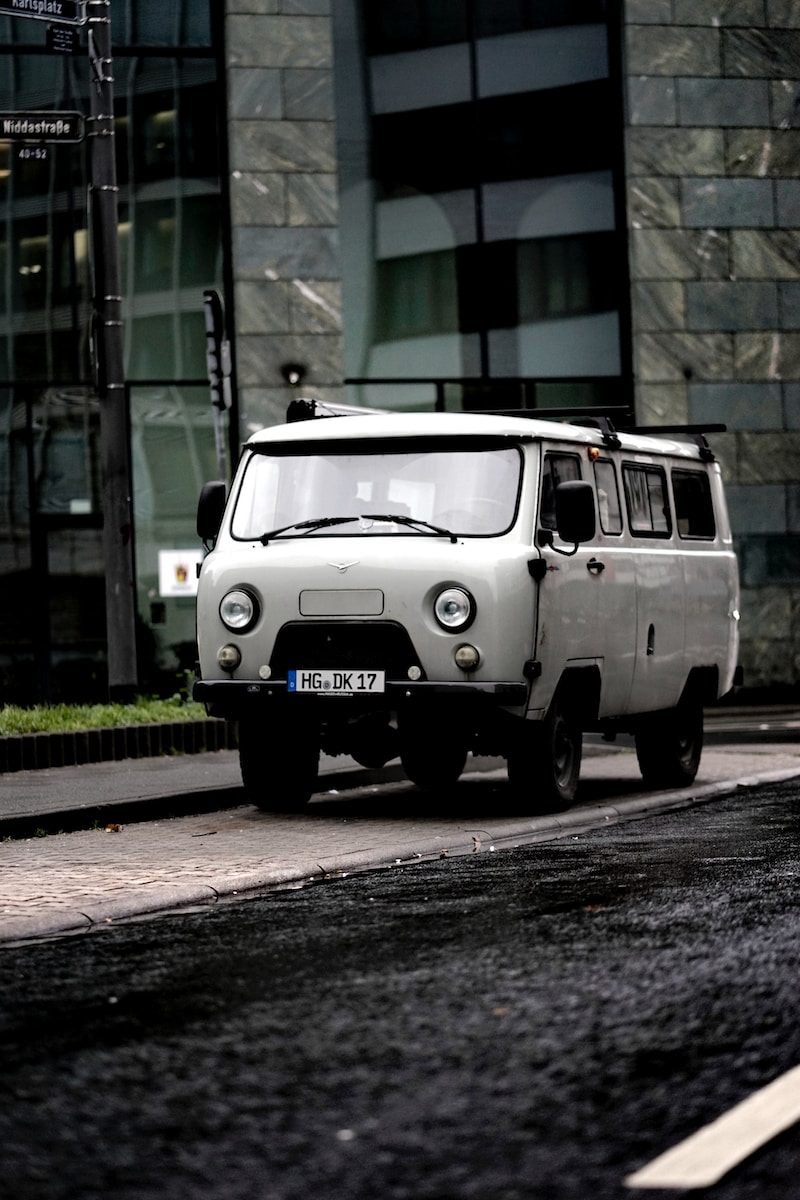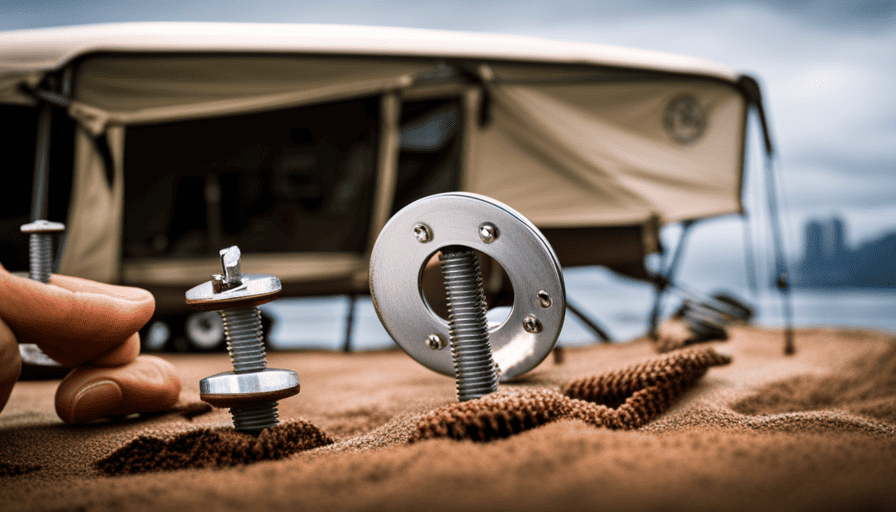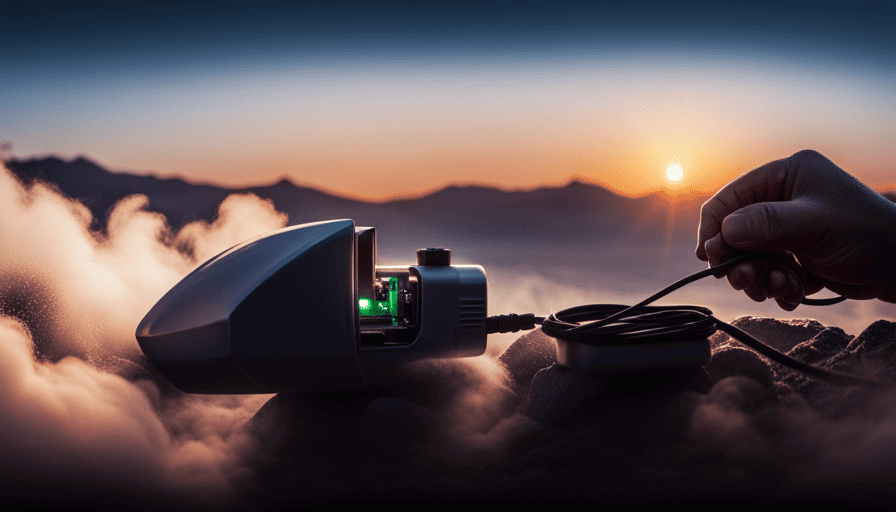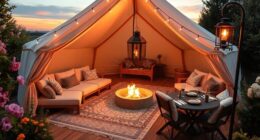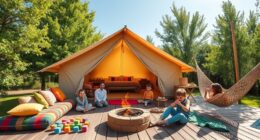Have you ever considered transforming a simple van into a cozy and functional camper? Rest assured, it’s easier than you think.
In fact, with the right guidance and a little bit of creativity, anyone can turn their van into the ultimate home on wheels.
In this article, we will take you through the step-by-step process of converting a van into a camper. From choosing the perfect van for your project to personalizing it to your own taste, we will cover everything you need to know.
But before we dive into the nitty-gritty details, let’s address the truth of the matter – converting a van into a camper is a labor of love. It requires time, effort, and a certain level of DIY skills. However, the end result is more than worth it.
Just imagine the freedom of hitting the road with your very own custom-made camper van, ready to take you on endless adventures.
So, let’s roll up our sleeves and get started on this exciting journey to create the camper van of your dreams!
Key Takeaways
- Choose the right van based on budget, space, and needs
- Plan layout and design for a comfortable living space
- Maximize storage space with shelves, cabinets, and multi-functional furniture
- Install electrical and plumbing systems for comfort and functionality
Choose the Right Van for Your Conversion Project
You need to find the perfect van that suits your conversion project, so start by researching and selecting the right one for you. Choosing the right van is crucial as it’ll determine the success and comfort of your camper.
Consider your budget, as it’s an important factor in determining the type of van you can afford. Keep in mind that larger vans, such as Sprinter or Transit, may offer more space but come with a higher price tag. On the other hand, smaller vans like the Volkswagen Transporter or Ford Transit Connect can be more affordable but may have limited space.
Think about your needs and preferences. Do you need a van with standing height, or is a low-roof van sufficient? Will you be traveling alone or with a partner? Do you require additional storage space for outdoor gear? Answering these questions will help you narrow down your options and find the van that meets your requirements.
Once you’ve chosen the right van, it’s time to plan your layout and design, maximizing the available space to create your dream camper.
Plan Your Layout and Design
Start by envisioning the perfect layout and design for your dream mobile home, allowing for a comfortable and functional living space that’ll make you feel right at home on the road.
Did you know that 95% of people who transform their vans into campers report increased happiness and satisfaction with their nomadic lifestyle? When planning your layout and design, consider color schemes and aesthetics that’ll create a calming and inviting atmosphere. Choose colors that reflect your personal style while also promoting a sense of tranquility.
Don’t forget to think about maximizing storage space in your van. Utilize every nook and cranny by installing shelves, cabinets, and drawers. Consider using multi-functional furniture pieces such as a bed with built-in storage compartments. This’ll help you keep your belongings organized and easily accessible.
In addition to color schemes and storage, think about the overall flow and functionality of your space. Design a layout that allows for easy movement and access to essential areas such as the kitchen, sleeping area, and bathroom. Create designated zones for cooking, dining, lounging, and sleeping. Remember, the key is to make the most of the limited space available while still maintaining a comfortable and efficient living environment.
Now that you’ve planned your layout and design, it’s time to move on to the next step of your van conversion journey: insulate and soundproof your van. By taking these measures, you can ensure a cozy and quiet living space, no matter where your travels take you.
Insulate and Soundproof Your Van
Enhancing the insulation and soundproofing of our mobile home contributes to a more comfortable and serene environment during our nomadic adventures. When it comes to soundproofing materials, there are a few options to consider.
Acoustic foam panels are a popular choice as they absorb sound waves and reduce noise. Another option is mass loaded vinyl, which is a dense material that blocks sound transmission. Additionally, installing sound deadening mats on the floor and walls can further reduce noise levels inside the van.
Insulation is equally important, as it helps regulate the temperature inside the camper. One common insulation option is spray foam, which expands to fill gaps and provides excellent thermal insulation. Another option is rigid foam insulation boards, which are lightweight and easy to install. Reflective insulation, consisting of reflective foil sheets, can also be used to keep the van cool during hot weather.
By incorporating these soundproofing materials and insulation options, we can create a cozy and quiet living space within our camper. Once we’ve finished insulating and soundproofing, we can move on to the next step of our van conversion journey: installing electrical and plumbing systems.
Install Electrical and Plumbing Systems
Now, let’s dive into the exciting world of transforming your mobile home by installing the mind-blowing electrical and plumbing systems that’ll bring your cozy sanctuary to life!
When it comes to van conversions, getting the electricity and water connections right is crucial for a comfortable and functional camper. Start by planning the layout and deciding where you want to place your outlets, switches, and water connections. This’ll help you determine the length of wires and pipes you’ll need. Remember to use waterproof and shock-resistant materials to ensure safety on the road.
Next, it’s time to get your hands dirty and start the installation process. Begin by running the electrical wires and plumbing pipes through the walls, making sure to secure them properly. Connect the wires to a power source, such as a leisure battery or an external hookup, for your electrical needs. For plumbing, install a water tank, a pump, and a sink to have access to clean water wherever you go.
Maintenance and troubleshooting are essential to keep your systems running smoothly. Regularly inspect the wiring for any signs of wear or damage, and promptly fix any leaks or blockages in the plumbing. It’s also a good idea to have a basic understanding of electrical and plumbing repairs, so you can handle minor issues on the road.
With your electrical and plumbing systems in place, you’re ready to move on to the next step: building the furniture and fixtures that’ll turn your van into a cozy home on wheels.
Build the Furniture and Fixtures
Begin by creating a cozy haven on wheels as you craft the furniture and fixtures that’ll transform your mobile home into a sanctuary that embraces your unique style and offers a comforting escape from the ordinary.
Building techniques play a crucial role in turning your van into a camper that maximizes space optimization. With limited square footage, it’s essential to make every inch count.
When it comes to building the furniture, consider using lightweight materials such as plywood or composite boards to minimize the overall weight of your camper. This won’t only make it easier to drive, but it’ll also help with fuel efficiency. Additionally, utilizing modular designs allows for flexible configurations, ensuring that your furniture can adapt to different needs and functions.
Think about the layout and placement of each piece of furniture carefully. Consider incorporating hidden storage compartments under benches or beds to make the most out of the available space. Install foldable tables and chairs that can be easily stowed away when not in use. Don’t forget to secure all fixtures properly to ensure stability while on the move.
As you build the furniture and fixtures, keep in mind the need to add comfort and amenities to your camper. By integrating cozy seating, soft bedding, and practical storage solutions, you can create a home away from home.
Add Comfort and Amenities
Transform your mobile home into a cozy oasis, where comfort and luxury intertwine, by adding plush seating, indulgent bedding, and convenient storage solutions. Upgrade your appliances to enhance your camping experience. Consider installing a compact refrigerator to keep your food and drinks fresh and cold. A small microwave can come in handy for quick meals on the go. And don’t forget a portable stove for cooking delicious meals outdoors. These upgraded appliances will make your van feel like a home away from home.
In addition to upgrading your appliances, organizing storage is essential for maximizing space and keeping everything tidy. Install overhead cabinets or shelves to store kitchen supplies, toiletries, and other essentials. Utilize under-bed storage compartments to keep your belongings easily accessible. You can also invest in hanging organizers for shoes, clothes, and other items. By utilizing clever storage solutions, you can ensure that everything has its place and your van remains clutter-free.
As you add comfort and amenities to your camper, it’s important to also consider safety and security. Implementing measures like installing a carbon monoxide detector, a fire extinguisher, and a security alarm system will provide peace of mind during your travels. By taking these precautions, you can enjoy your cozy oasis while ensuring the safety of yourself and your fellow travelers.
Ensure safety and security by following these guidelines and then move on to the next step of turning your van into the camper of your dreams.
Ensure Safety and Security
Now that we’ve added comfort and amenities to our camper van, it’s crucial to ensure safety and security for our upcoming adventures. After all, our van will be our home away from home, and we want to feel safe and protected during our travels.
First and foremost, we need to focus on the safety aspect. Installing smoke and carbon monoxide detectors is a must, as it’ll alert us in case of any potential hazards. Additionally, having a fire extinguisher on board is essential for quick response in case of emergencies. We should also invest in a sturdy door lock and window security film to deter any unwanted intruders.
When it comes to security, there are a few measures we can take to protect our belongings. Installing a reliable alarm system and GPS tracker will give us peace of mind, knowing that our van is secure even when we’re not around. Adding window curtains or blinds will also provide privacy and prevent prying eyes from seeing inside.
Ensuring safety and security in our van is of utmost importance before hitting the road. Once we’ve taken all the necessary precautions, we can move on to the next step: testing and inspecting our camper van to ensure everything’s in perfect working order.
Test and Inspect Your Camper Van
Make sure to thoroughly examine and assess the condition of your home-on-wheels to ensure a worry-free and blissful journey. Before hitting the road, it’s crucial to conduct a comprehensive inspection of your camper van.
Here is a maintenance checklist to help you get started:
-
Inspecting essentials: Begin by checking the overall structure of your van, including the roof, walls, and floor. Look for any signs of damage, leaks, or wear and tear. Don’t forget to inspect the windows, doors, and locks to ensure they’re secure and functioning properly.
-
Electrical and plumbing systems: Test all electrical components, such as lights, outlets, and appliances, to ensure they’re in working order. Check for any loose wires or faulty connections. Similarly, inspect the plumbing system for leaks, proper water flow, and functionality of faucets and toilets.
-
Mechanical components: Evaluate the engine, brakes, tires, and suspension system. Look for any signs of wear, such as uneven tire tread or brake pad thinning. Consider having a professional mechanic inspect these components for added peace of mind.
-
Safety equipment: Verify the functionality of safety equipment, including fire extinguishers, smoke detectors, carbon monoxide detectors, and emergency exits. Replace batteries if needed and ensure all equipment meets safety standards.
By following this maintenance checklist, you can ensure that your camper van is in top-notch condition for your upcoming adventures.
In the next section, we’ll explore how to personalize your camper van to make it truly feel like home on the road.
Personalize Your Camper Van
Enhance your travel experience by customizing your home-on-wheels to reflect your unique style and make it a cozy haven on the road. Personalizing your camper van allows you to create a space that feels like home, no matter where you are.
One of the first things to consider when customizing your van is the interior. Get creative with the colors, fabrics, and decorations to match your personality. Add curtains, throw pillows, and rugs to make the space feel warm and inviting. Don’t forget to incorporate functional elements as well. Look for creative storage solutions that maximize the use of space, such as overhead compartments, under-bed storage, and hanging organizers. These will help keep your belongings organized and easily accessible during your travels.
In addition to customizing the interiors, consider adding unique touches to the exterior of your camper van. Paint it in your favorite color or add decals and stickers that represent your interests. This will not only make your van stand out on the road but also give it a personal touch that reflects your style.
Now that you’ve personalized your camper van, it’s time to hit the road and enjoy your adventure! Take in the breathtaking views, explore new places, and create memories that will last a lifetime. Your customized van will be your cozy haven as you embark on this exciting journey. So, buckle up and get ready for an unforgettable camper van adventure!
Hit the Road and Enjoy Your Camper Van Adventure!
Get ready to embark on an unforgettable adventure as you hit the road and fully enjoy your customized home-on-wheels! With your personalized camper van, you have the freedom to explore countless camping destinations and create memories that will last a lifetime. Whether you prefer the serene beauty of national parks or the excitement of bustling cities, your camper van allows you to experience it all.
One of the best aspects of traveling with a camper van is the budget-friendly options it provides. Instead of spending money on expensive hotels and restaurants, you can prepare your own meals and camp in affordable or even free locations. Many campgrounds and public lands offer campsites for a fraction of the cost of traditional accommodations. Additionally, by being able to cook your own meals, you can save money on dining out and have the flexibility to eat whenever and wherever you choose.
As you venture to different camping destinations, take full advantage of the amenities and activities available. Whether it’s hiking through scenic trails, fishing in tranquil lakes, or simply enjoying the tranquility of nature, there is something for everyone. And at the end of each day, you can retreat to the comfort of your camper van, knowing that you have a cozy and familiar space to call home.
So, gather your loved ones, pack your belongings, and set off on the open road. Your camper van adventure awaits, filled with endless possibilities and unforgettable experiences. Get ready to create memories and discover the beauty of the world, all while staying within your budget.
Frequently Asked Questions
What are the legal requirements for converting a van into a camper?
When it comes to converting a van into a camper, there are a few legal requirements that need to be met. These requirements vary depending on your location, but typically include things like adding windows, a bed, and cooking facilities.
Additionally, you will need to ensure that your insurance coverage is adequate for a camper van. It’s important to research and understand the specific regulations and guidelines in your area to ensure that your conversion meets all legal requirements.
How do I choose the right size van for my conversion project?
Choosing the right size van for your conversion project is crucial. Consider your specific needs and preferences. Think about the interior layout and how much space you require for sleeping, cooking, and storage.
Also, take into account the vehicle’s dimensions, including height and length, to ensure it’ll fit in parking spaces and be easy to drive. Don’t forget to consider weight limits and towing capacity.
These van conversion tips will help you find the perfect fit for your camper project.
What are the best materials to use for insulating and soundproofing a camper van?
When it comes to insulating and soundproofing your camper van, there are a few materials that work exceptionally well.
For insulation, we recommend using materials like closed-cell foam or mineral wool, as they provide excellent thermal resistance.
To soundproof your van, consider using mass-loaded vinyl or acoustic foam, which absorb and block unwanted noise.
These materials will help create a comfortable and quiet living space inside your camper van, allowing you to enjoy your travels to the fullest.
How do I determine the electrical and plumbing needs for my camper van?
Determining power usage and designing a plumbing system for a camper van requires careful planning.
To start, assess your electrical needs by considering the appliances and devices you’ll be using on the road. This will help determine the size of your battery bank and the type of power inverter you’ll need.
When it comes to plumbing, factor in your water usage habits and the space available for tanks and pipes.
An efficient and well-designed system is key to a comfortable camper van experience.
Are there any special permits or licenses needed to drive and park a camper van?
Yes, there are special permits and parking restrictions that may apply when driving and parking a camper van. It’s important to check with your local Department of Motor Vehicles or transportation authority to determine the specific requirements for your area. Special permits may be needed for oversized vehicles, and there may be restrictions on where you can park overnight.
It’s essential to familiarize yourself with these regulations to ensure a smooth and hassle-free experience while traveling in your camper van.
Can Changing a Camper Awning Help Turn a Van Into a Camper?
Changing a camper awning can certainly help turn a van into a more functional and comfortable camper. A new awning can provide much-needed shade and outdoor living space, expanding the usable area of the van. With the right awning, campers can enjoy meals, relax, or even sleep outside, making the van experience more enjoyable and versatile.
Can the same techniques be used to turn a car into a camper as a van?
Yes, you can definitely turn your car into camper using the same techniques as with a van. With proper planning and customization, you can create a comfortable and functional living space in your car, complete with sleeping quarters, storage, and cooking facilities. It’s a great way to maximize your vehicle’s potential for adventure.
Conclusion
In conclusion, embarking on the journey of converting a van into a camper is an exciting and rewarding experience. By carefully choosing the right van, planning the layout, and insulating it for comfort, you can create a home on wheels.
Installing electrical and plumbing systems, building furniture, and ensuring safety and security are crucial steps in the conversion process. After testing and personalizing your camper van, you’ll be ready to hit the road and embark on unforgettable adventures.
So, let the wanderlust take over and set forth on your camper van adventure, where freedom knows no bounds!

